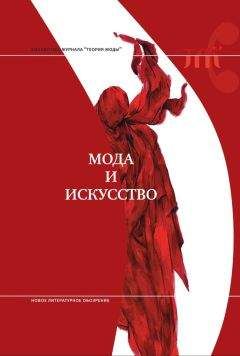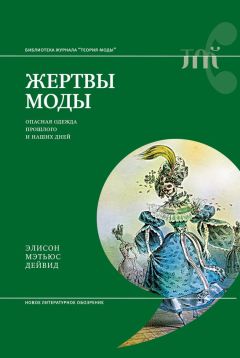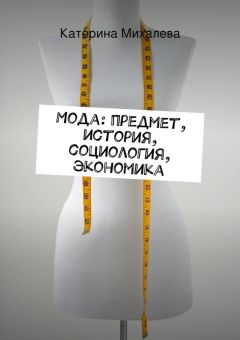166
Согласно Оксфордскому словарю английского языка, тело – это «физическая или материальная основа или структура человека» [sic].
Eicher J.B., Roach-Higgins M.E. Describing Dress: A System of Classifying and Defining // Dress and Gender: Making and Meaning in Cultural Context / Еd. by R. Barnes and J.B. Eicher. Oxford; Washington, DC: Berg Publishers, 1992. Pp. 8–28. Мэрилин Делонг дает свое определение понятию «одежда», исходя из концепции «ABC» – «Apparel – Body – Construct» («Одежда – Тело – Концепция»); подробнее об этом можно прочитать в книге: DeLong M. The Way We Look: Dress and Aesthetics. N.Y.: Fairchild Pubs., 1998. Джоанн Энтуисл называет одежду «обусловленной ситуацией телесной практикой», что, в сущности, близко к концепции преображения тела и восполнения недостающего; см.: Entwistle J. The Fashioned Body. London: Sage, 2000. P. 39.
Tortora P., Eubank K. Survey of Historic Costume. N.Y.: Fairchild, 2009. P. 8.
Эта картина принадлежит Институту искусств Стерлинга и Франсин Кларк (Уильямстаун, штат Массачусетс, США), но репродукция и более подробная информация о картине доступны в Интернете (см.: www.tfaoi.com/permc/perm10c.htm).
Еще несколько кадров из фильма «Зуд седьмого года» (с участием Монро, одетой в то же платье) можно найти в Интернете (см.: www.imdb.com/media/rm1285330944/tt0048605).
Картина принадлежит Филадельфийскому музею искусств; более подробную информацию о ней можно найти на официальном сайте музея: www.philamuseum.org/collections/permanent/51449.html.
Eicher J. Dress // Routledge International Encyclopedia of Women: Global Women’s Issues and Knowledge / Ed. by C. Kramarae and D. Spender. N.Y.: Routledge, 2000. P. 422.
Информация найдена на интернет-сайте Richard Avedon Foundation (www.richardavedon.com/).
Loschek I. When Clothes Become Fashion: Design and Innovation Systems. Oxford: N.Y.: Berg, 2009. P. 17.
About Race: A Public Education Project, American Anthropological Association. См.: www.aaanet.org/resources/A-Public-Education-Program.cfm.
Каолин и мел, природные материалы белого цвета, изначально использовались в ритуальных целях, иногда ими покрывали все тело.
Geoffroy-Schneiter B. Africa is in Style. N.Y.: Assouline, 2006.
Pine F. Gender // Encyclopedia of Social and Cultural Anthropology / Ed. by A. Barnard and J. Spencer. London; N.Y.: Routledge, 1998. P. 253.
Willis R. Body // Encyclopedia of Social and Cultural Anthropology. Pp. 75–76.
Coleridge N. The Fashion Conspiracy. London: Heinemann, 1988.
Balasescu A., Moise R. Paris Chic, Tehran Thrills: Aesthetic Bodies, Political Subjects. Bucharest: Zeta Books, 2007.
Cathy Horyn. Remembering a Renegade Designer // New York Times. 2010. September 21.
Впервые эта концепция была представлена в 1981 г. Ее авторы, Эрекозиман и Эйчер, описали четыре процесса: отбор, описание основных характеристик, интеграция и трансформация. Суть основной идеи в том, что творческое переосмысление и переработка так называемых заимствований в результате порождает новые «культурно-аутентифицированные» артефакты, которые отнюдь не являются обычной имитацией. См.: Erekosiman T.V., Eicher J.B. Kalabari Cut Thread Cloth: An Example of Cultural Authentication // African Arts. Vol. 14. No. 2. 1981. February. Pp. 48–51.
Farrell-Black J., Gau C. Uplift. The Bra in America. Philadelphia: University of Pennsylvania Press, 2002.
Репродукцию портрета Генриха VIII нетрудно найти в Интернете, в том числе в Википедии: en.wikipedia.org/wiki/Portrait_of_Henry_VIII.
Lajer-Burcharth E. Pompadour’s Touch: Difference in Representation // Representations. Winter 2001. Vol. 73. No. 1. P. 74.
Halliday T. Facing the Public: Portraiture in the aftermath of the French Revolution. Manchester, 1999. P. 2.
См.: Palmer С. Brazen Cheek: Face-Painters in Late Eighteenth-Century England // Oxford Art Journal. 2008. No. 31. P. 202; Hyde M. The “Makeup” of the Marquise: Boucher’s Portrait of Pompadour at her Toilette // Art Bulletin. 2000. September. Vol. 82. No. 3. P. 460.
Палмер напоминает, что цвета, которые мы видим на картинах сегодня, – не те же, что видели современники. Мы можем оценить лишь контраст между красным, розовым и белым на лице и общий размер и форму нарумяненных участков (хотя они тоже могли уже выцвести). Palmer С. Op. cit. Pp. 197–198.
Об опасностях использования косметики см.: Martin M. Selling Beauty: Cosmetics, Commerce, and French Society, 1750–1830. Baltimore, MD, 2009. Chap. 4. Парики обладали сходной способностью одновременно интегрировать их носителя в общество и подрывать его положение. См.: Pointon M. Hanging the Head: Portraiture and Social Formation in Eighteenth-Century England. New Haven, CT, 1993. P. 121.
См. напр., у актрисы Клерон, поощрявшей и макияж, и естественные эмоции: Clairon C. Mémoires de Mademoiselle Clairon. Paris, 1822. Pp. 264–265, 267.
См.: Martin M. Op. cit. Chap. 6.
Lichtenstein J. Making up Representation: The Risks of Femininity // Representations. 1987. No. 20. Pp. 78–79.
Reilly P. Writing Out Color in Renaissance Theory // Genders. Winter 1991. No. 12. Pp. 83, 89, 90.
De Piles R. Le Cours de Peinture par Principes / Oeuvres Diverses. Amsterdam, 1767. T. 2. P. 274.
Ibid. Pp. 213–216.
Diderot D. Essais sur la peinture pour faire suite au Salon de 1765 / Salons / Ed. Michel Delon. Paris, 2008. P. 180; Reilly P. Op. cit. P. 83.
Sheriff M. Invention, Resemblance, and Fragonard’s Portraits de Fantaisie // The Art Bulletin. March 1987. Vol. 69. Nо. 1. P. 78. См. также: Pointon M. Op. cit. Pр. 79–81.
Diderot D. Op. cit. P. 180.
Rouquet A. The Present State of the Arts in England (1755), цит. по: Rosenthal A. Visceral Culture: Blushing and the Legibility of Whiteness in Eighteenth-Century British Portraiture // Art History. 2004. September. P. 575.
Antoine Coypel. Discours sur la peinture 1708–1721 – La grace, le naïf, le charme du pinceau. Цит. по: Cochet V. Le Fard au XVIIIe siècle: Image, Maquillage, Grimage / Imaginaire et creation artistique а Paris sous l’ancien régime / Ed. Daniel Rabreau. Bordeaux, 1998. P. 108.
Palmer C. Op. cit. P. 212.
Hyde M. Making up the Rococo: François Boucher and His Critics. Los Angeles, 2006. P. 86.
Crow T. Painters and Public Life in Eighteenth-Century Paris. New Haven, CT, 1985. P. 91.
Piper D. The English Face. London, 2006. P. 153.
The Champion (1817), цит. по: Pointon M. Op. cit. P. 2.
Pointon M. Op. cit. Pp. 38–39; Lajer-Burcharth E. Necklines: The Art of Jacques Louis-David after the Terror. New Haven, CT, 1999. Pp. 240–241.
Цит. по: Festa L. Cosmetic Differences: The Changing Faces of England and France // Studies in Eighteenth-Century Culture. 2005. No. 34. P. 33.
См.: Martin M. Op. cit. Chap. 4.
Hyde M. Op. cit. P. 83. О Буше и моде в искусстве см. также: Brunel G. Boucher / Trans. Simon Rees et al. N.Y., 1986. P. 299.
Diderot D. Essais sur la peinture pour faire suite au Salon de 1765 / Salons / Ed. Michel Delon. Paris, 2008. P. 106.
La Font, цит. по: Hyde M. Op. cit. P. 90.
Soulavie J.L. Mémoires historiques et anecdotes de la cour de France pendant la faveur de la marquise de Pompadour. Paris, 1802. P. 363.
Ibid. P. 367. См.: Lajer-Burcharth E. Pompadour’s Touch: Difference in Representation // Representations. Winter 2001. Vol. 73. No. 1. P. 70.
d’Argenson M. Mémoires et journal inédit du marquis d’Argenson. Paris, 1857. Vol. IV. P. 264; Walpole to Mann, Paris, February 23, 1756 / Walpole H. Letters of Horace Walpole. Edinburgh, 1906. Vol. II. Pp. 507–508; Hyde M. Op. cit. Pp. 109–110, 130.
См., напр., цитату из Андре Руже в: Rosenthal A. Visceral Culture: Blushing and the Legibility of Whiteness in Eighteenth-Century British Portraiture // Art History. 2004. September. P. 583.
Pointon M. Op. cit. P. 123.
Rosenthal M. The Art of Thomas Gainsborough: A Little Business for the Eye. New Haven, CT, 1999. P. 179.
Pasquin A. An Authentic History of the Professors of Painting, Sculpture and Architecture… in Ireland. London, 1796. P. 12. Цит. по: Palmer С. Op. cit. P. 205.
Palmer C. Op. cit. P. 208.
Томас Гейнсборо. Грейс Далримпл Эллиот. 1778. Галерея Фрика, Нью-Йорк. Источник: Frick Collection, Collections.frick.org. О критике этого портрета за аморальность см.: Perry G. The Spectacle of the Muse: Exhibiting the Actress at the Royal Academy / Art on the Line: The Royal Academy Exhibitions at Somerset House, 1780–1836 / Ed. David H. Solkin. New Haven, CT, 2001.
Piper D. Op. cit. P. 190.
Гейнсборо, однако, пытался изменить образ леди Дартмут, когда работал над ее портретом, попросив ее одеться «на новый манер» и желая знать, пудрит ли она волосы постоянно. Piper D. Op. cit. P. 189.
Lindsay J. Thomas Gainsborough: His Life and Art. N.Y., 1981. P. 107. Пипер пишет, что трудно судить о палитре Рейнольдса, поскольку его картины поблекли. Piper D. Op. cit. Pp. 190, 209.
Джошуа Рейнольдс. Эстер Линч Трейл с дочерью. 1777–1778. Галерея Бивербрук, Фредериктон, Нью-Браунсуик, Канада; Autobiography, Letters and Literary Remains of Mrs. Piozzi / Ed. A. Hayward. London, 1861. Vol. II. P. 12; Mangin E. Piozziana or Recollections of the Late Mrs Piozzi with Remarks by a Friend. London, 1833. Pp. 9, 212–213; Ribeiro A. Dress in Eighteenth-Century Europe 1715–1789. N.Y., 1985. P. 109.
См. Портрет кисти неизвестного, ок. 1785 (Национальная портретная галерея в Лондоне), в: Ribeiro A. The Gallery of Fashion. Princeton, NJ, 2000. P. 143.
Rosenthal A. Op. cit. Pp. 576–578.
Palmer C. Op. cit. P. 209.
Garb T. The Painted Face: Portraits of Women in France, 1814–1914. New Haven, CT, 2007. P. 3.
Пьер Нарсис Герен. Бюст девушки. 1794. Лувр, Париж.
Fend M. Bodily and Pictoral Surfaces: Skin in French Art and Medicine 1790–1860 // Art History. June 2005. Vol. 28. No. 3. P. 315.
Жак-Луи Давид. Портрет маркизы де Сорси де Теллюсон. 1790. Новая Пинакотека, Мюнхен. Более полный анализ этой картины см.: Martin M. Op. cit. Pp. 177–178. На другом портрете кисти Давида здоровый румянец, приобретенный на открытом воздухе, сочетается с народным платьем. Жак-Луи Давид. Эмилия Сериза. 1795. Лувр, Париж.




